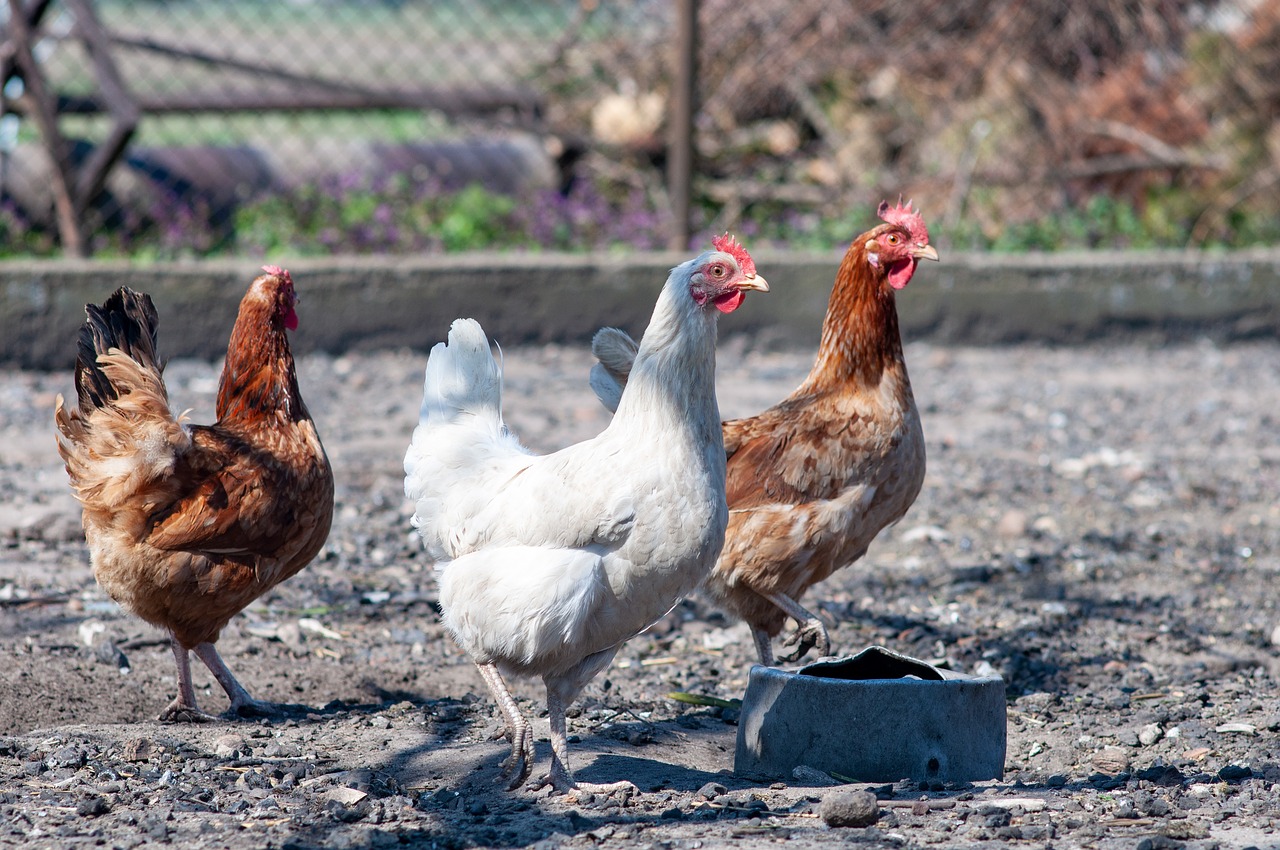Chickens aren’t finicky creatures. There’s not much you need to know in order to raise them, baring feeding and housing requirements, of course.
However, one of the most important things you need to keep in mind is that these birds don’t like to be crowded.
While you don’t need to have a hundred acres of land out in the countryside to raise a happy flock, you do need to make sure you provide them with ample room to stretch their legs.
Here is everything you need to know in order to raise a backyard flock of chickens that is healthy, thriving, and productive.
How Much Space Do Chickens Need?

A common misconception is that you need at least an acre of land to keep chickens on your property.
This is far from the truth, and there are a lot of caveats to chickens and their space requirements that you need to keep in mind.
Obviously, the amount of space you need for your chickens will vary depending on several factors, such as:
- How many chickens you choose to keep
- Where you live
- Whether you are keeping roosters as well as hens
- How long you intend to raise your birds
- How much space they have to free range
- Your weather
- Whether or not you keep large breed of chicken
As a general rule of thumb, most people don’t keep fewer than six chickens.
Why?
Many states poultry buying regulations specify that you must buy birds in quantities of six or more to prevent people from raising them up as pets (instead of for agricultural purposes).
Therefore, if you are starting off with six chickens, you will need a coop that is at least 18 square feet, along with a run that is at least 90 square feet.
In total, you will need at least 110 square feet (give or take a few feet) to keep six chickens.
Generally speaking, a chicken needs about three to four square feet of coop space per adult bird.
However, the calculations aren’t always that simple.
For example, if you are keeping chickens solely in confinement in a chicken coop, you will need more indoor space.
If you are able to allow your chickens to free range, you can get away with less indoor space- but will need to provide more range outside.
In this article, we’ll break things down a bit further so that you understand all of the factors that go into providing enough space for your chickens.
What Problems Can Overcrowding Cause?
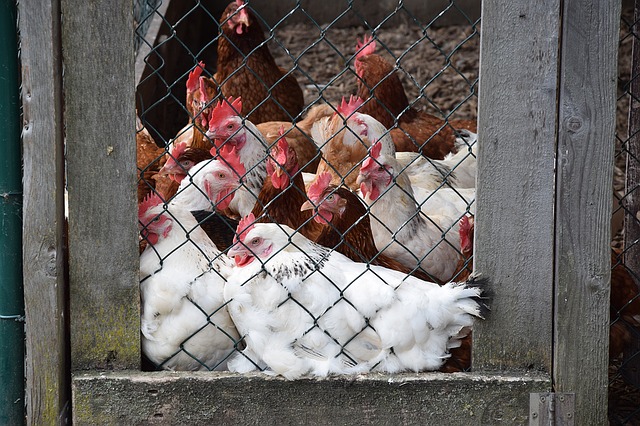
If you’re new to raising chickens, you might think you can scrape by and provide just a few square feet for your entire flock.
Don’t do it!
Overcrowding can cause a whole host of problems, and it will be more hassle than it is worth in the long run.
Legal Issues
Many municipalities have strict rules about the number of chickens you can keep, as well as the stocking density.
In many places, you may not raise more than six chickens, roosters are not allowed, or you may be subjected to agricultural inspections.
Read these carefully before building your chicken housing, as you’ll want to stay apprised of any potential legal issues related to poultry overcrowding.
Social Problems
Raising too many chickens in too small a space can lead to some serious social problems.
We’re not just talking about your neighbors getting annoyed with the smell of chicken manure, either!
Like people, chickens get cranky when they’re overcrowded.
They need personal space as well as room to eat, drink, clean themselves, and sleep in peace.
If you cram too many chickens into a crowded space, they’ll start to bicker.
This bickering can lead to aggressive behavior, cannibalism, and other issues, causing your chickens to develop patchy feathers or sore spots. They could even die.
Bored, cramped chickens are more likely to engage in the following behaviors:
- Reduction in feed intake, which can cause a drop in yields
- Feather pecking
- Feather pulling
- Decreased activity, leading to obesity
Decline in Egg Production
If you don’t give your chickens enough room to lay their eggs, you’ll likely face one of the following problems.
- Broken or cracked eggs: Chickens that are overcrowded in the nest boxes have a tendency to move around repeatedly, shifting until they find a comfortable place to lay their eggs. The result of this movement? They’re more likely to crush the eggs that have already been laid.
- Dirty eggs: If you don’t give your chickens plenty of room to do their business, guess what? They’ll do their business wherever they please – and that includes on the eggs in the nest box.
- Egg binding: When hens are stressed, which is a common side effect of overcrowded chicken coops, they will have a hard time laying their eggs. As a result, eggs can become trapped and cause serious health problems – or even death – in your laying hens.
- Misshapen eggs: If hens struggle to lay eggs in crowded conditions, they are more likely to lay misshapen eggs. If you keep eggs for raising baby chicks, you may also found that chicks whose mothers were overcrowded have increased levels of mortality and other birth defects.
- Drop in production: When your birds are crowded, they could stop laying eggs altogether – something you definitely don’t want to have to deal with, even if you’re just raising chickens to produce enough eggs for your own family.
Disease
Put too many chickens together in one place, and your likelihood of disease is going to skyrocket – just as it does with people living in crowded cities.
If you are keeping eight birds in 32 square feet, they are going to produce twice as much manure as four birds in the same space – that’s just basic logic.
If you have tons of birds in a coop, you’re going to have to clean it far more often.
Plus, crowded chickens are more likely to knock over feed and water buckets, meaning the coop’s bedding will become soiled more quickly.
Crowded hens are also more likely to fight, as we already mentioned, creating sores that will become vectors for infection.
To make matters worse, microbes that transmit diseases are more likely to survive – and thrive – in crowded, dirty coops.
Therefore, you need to consider how much space you are providing your chickens to help prevent diseases and other health problems such as:
- Chicken mites
- Premature molting
- Infectious bronchitis
- Respiratory abnormalities
- Head, wattle, beak, and other congenital bodily deformities
- Rotgut
- Aspergillosis
- Lameness
- Coccidiosis
- Fowl pox
- Marek’s disease
Start overcrowding your coop, and you’ll likely find that your chicken mortality rate increases – even in visibly healthy birds.
How Big Should My Chicken Coop Be?
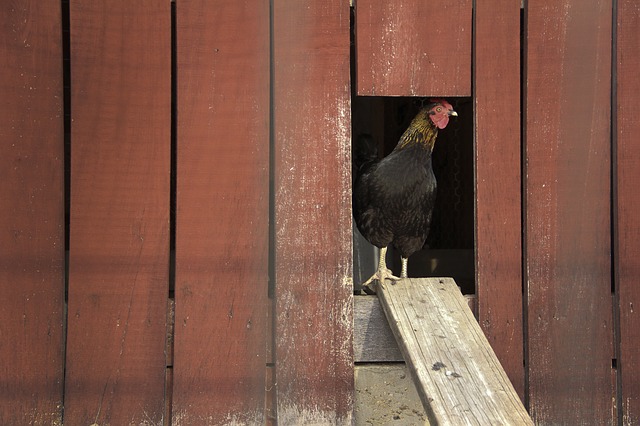
Plan out a chicken coop that is larger than you think you will need.
Even if you are providing your chickens with outdoor space, remember that the outdoor space should not contribute to the amount of indoor space you decide your chickens need.
Extra outdoor space gives your chickens a place to enjoy fresh air and exercise, but unfortunately, you can’t always rely on it.
What will you do when snow covers the ground and makes it difficult for your chickens to move? What if it’s raining hard? What if you develop a predator problem?
Any outdoor space should be considered bonus space and not factored into the size of your chicken coop itself.
To be clear, a chicken coop is any structure that is used to house your chickens.
It doesn’t need to be a fancy, premade coop that you buy from a major retailer like Tractor Supply.
It could be as simple as a converted backyard tool shed or a corner of your barn.
However, a coop is only the building itself and does not include any outdoor space, like a covered pen or a run.
Inside the coop, you will need to provide your chickens with a minimum of three square feet per bird.
A common mistake is to overcompensate by providing your chickens with a palatial coop, giving them more room than they could ever possibly use.
While this will be fine at some points throughout the year, you need to keep in mind that chickens need to be kept in somewhat close quarters because they will use each other to generate body heat and stay warm.
When you’re calculating how much space you need inside of your chicken coop, don’t assume that just because you have six chickens that you can get by with an 18 square foot chicken coop.
You’ll also need to save room for your nest boxes, roost bars, feeders, and waterers.
How Big Should My Nest Boxes Be?
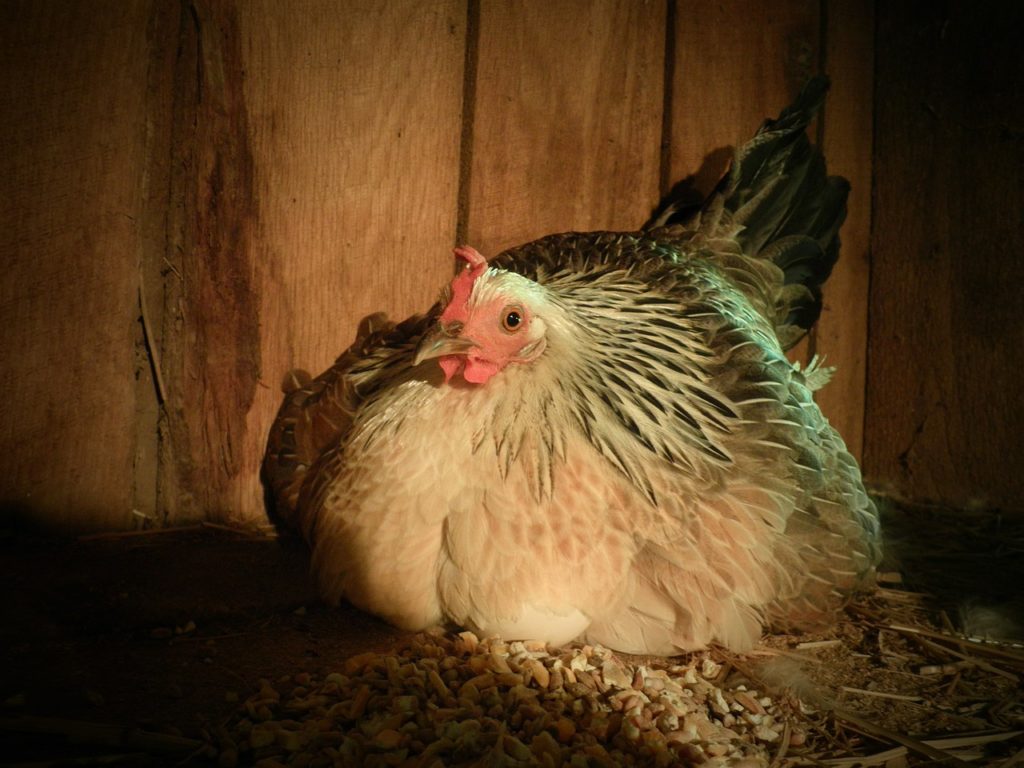
You have several options when it comes to nesting boxes in your coop.
You can affix these to the outside of the coop, giving your chickens a spot to enter the boxes from the inside of the coop, or you can have them fully enclosed inside the coop.
If you choose the former option, this has a benefit in that the nest boxes won’t take up extra room inside your coop, meaning you might be able to make do with a smaller coop design.
In addition to those spatial considerations, you also need to decide on the design of your nest boxes.
Do you want an open nest box or separate individual nest boxes? Individual boxes provide more privacy but take up a bit more space.
Privacy is important to laying hens as it can increase egg production and viability, improving your overall yields.
Regardless of the choice you make, know that you will need about one cubic foot per chicken in the nest box.
Therefore, if you select an open nesting box, you will need to provide a box that is six feet by one foot deep for a flock of six laying hens.
Not sure you’ll have enough space for individual nest boxes but want to give your girls some extra privacy nonetheless? Consider hanging curtains over the box.
This can help reduce egg-related squabbling and production by giving your hens the illusion of privacy.
Hens also tend to lay better when they are in a somewhat darkened setting.
How Much Space Do Chickens Need to Free Range?
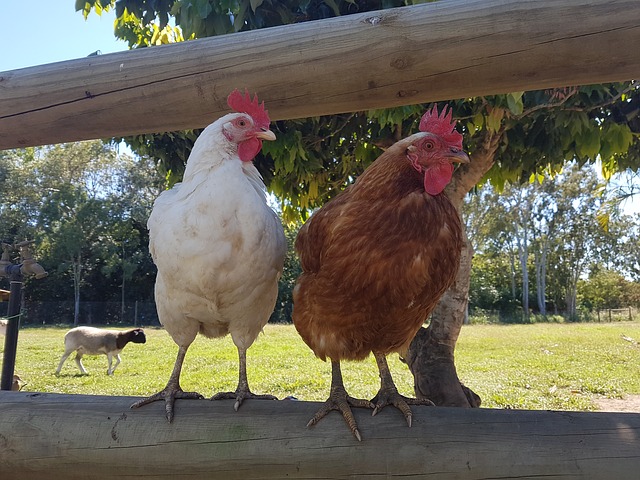
Chickens need plenty of outdoor space. It is rare to be able to raise a large number of birds in complete confinement with any success.
Your birds will want to have outdoor space to dust themselves and have access to tasty morsels like bugs and grass.
Chickens who are allowed to free range tend to be happier, healthier, and more productive.
If you are allowing them to roam free, the best way to calculate how much outdoor space your chickens need is to multiply the number of chickens you have by fifteen – that will be the square footage required.
However, keep in mind that fifteen square feet per bird isn’t a lot of space.
Instead, you might want to up that number to at least 25 per bird whenever possible.
To be classified as free range by the United States Department of Agriculture, a chicken simply needs to have access to outside space.
Therefore, there are no legality issues related to allowing chickens outside – you just need to provide a small amount of space if you plan on selling eggs as “free-range.”
If you are allowing your chickens to free range, you have several options for how you do this. You can create a run, build a portable run, or let them run about in the garden.
Keep in mind that there are several advantages and disadvantages that each option presents, and be prepared to deal with those potential drawbacks if necessary.
If you’re raising chickens in the garden for the first time, start out with as few chickens as possible.
Chickens can decimate your garden by foraging too much, which can kill your plants from consumption or too much nitrogen from their manure.
However, keep chickens in a run and there are issues to contend with, too. While a permanent run is easier to maintain in that it does not need to be moved every day, chickens who are kept in a permanent run will need to be moved at least occasionally.
During the winter and early spring, the run will become wet and boggy, which can become an issue if you have birds with fully feathered legs that are not waterproof (like Silkies).
If you are keeping your chickens in mobile, tractor-style coops, you can get along with less square footage per bird.
This is because both the coop and run are moved every day, giving them access to fresh pasture at all times.
This keeps them engaged and active in natural foraging behaviors. It also helps reduce the likelihood of disease.
However, as we mentioned, there is extra labor involved in needing to be moved every day, and these don’t always offer great protection when it comes to exposure to the elements, either.
The bottom line? Choose the set-up that works best for you, but remember that the more outdoor space you can give your birds, the better.
What Other Factors Should I Consider?
When you’re planning out your chicken coop and run space, remember that most people have a tendency to underestimate how much space their chickens need. Consider these factors as you are getting started.
Breed and Gender Distribution
Some species of chickens, particularly those that are bantams, or miniature versions of chickens, require less space.
Since these chickens are smaller, they don’t need as much room and can easily get by with just a square foot or two of spaces.
Remember, though, that they still need some space and that bantam breeds are less likely to produce high quantities of eggs or meat.
The following breeds tend to do best in confinement:
- Delaware
- Brahma
- Silkie
- Orpington
- Wyandotte
The gender of your chickens also plays a role. While hens and roosters can easily be kept together, remember that hens are just as likely to exhibit aggressive behaviors as roosters.
However, roosters are larger and equipped with sharper spurs, meaning it is more likely that a crowded rooster will present more serious problems.
Broodiness
Do you plan on allowing your broody hens to raise chicks that will be integrated with the flock? If so, you need to provide her with extra room to do so.
Flock Introduction
You need to be careful about introducing new chickens to a crowded -or even filled-to-capacity – chicken coop or run.
You should always avoid adding chicks, waiting until they are at least ten years old and fully feathered.
You should make a point of keeping them behind a separate fence until they need to be fully introduced.
All of the problems that can arise as a result of an overcrowded chicken yard are magnified with the introduction of new birds, particularly young ones.
This can cause fighting, a delay in egg production, and even death.
Number of Chickens
Obviously, the more chickens you have, the more space you will need to provide them. It’s always better to err on the higher side of things.
After all, things happen and it’s better to have slightly too much space than too little.
Weather
How often will your birds be allowed to go outside? Do you experience harsh winters?
If the latter is true, it may be worth your while to consider building a larger coop and cutting down on some of the size of the run instead.
Food and Water Positioning
Remember that your feeders and waterers will take up valuable space inside your coop or run.
Factor in the size of these units when you are planning out your coop – and remember that they are non-negotiables.
While some people get by with hand-feeding their chickens once a day, it is much healthier for your birds to provide them with free choice feed.
Make sure you have plenty of space for both a feeder and waterer inside your coop. You also need to make sure that they are out of the way of the roost bars, so they don’t become covered with manure every night.
Roost Spacing
Providing lots of indoor coop space isn’t enough to keep your chickens happy. They also need plenty of roost space.
Each chicken should be granted about ten inches of perching space. For six chickens, that means you will need a roost bar that is at least five feet long.
While your chickens won’t likely use these bars at all times – they will often huddle together at night to stay warm – you want to provide slightly more roost space than you think they might need or actually use.
Don’t be discouraged if you don’t see them using all the available roost space at all times.
Waste Load
The larger coop you have, the less often you will need to deal with poop.
Obviously, chickens will produce the same amount of poop regardless of the space that they are occupying.
However, a crowded space will become stinky much more quickly.
You can manage manure by utilizing methods such as deep litter bedding or droppings boards, but it’s easier to simply keep an eye on the size of your flock.
Tips for Getting By With Less Space
So you find yourself stuck with more chickens than you originally planned on. While the best (and wisest) possible solution would be to build a bigger coop or run, we know that this is sometimes not possible. Here are some tips to help you improve the situation in the meantime:
- Smart Positioning: If your coop is exceptionally crowded but you have plenty of outdoor space, consider placing your food and water systems outside. This will free up some floor space in the coop.
- Gardening Access: allow your chickens to free-range in the garden. This will give them more space and will also help reduce the bio load on the coop and run.
- Toys: Giving your chickens plenty of toys, such as obstacles or hanging tetherballs, can provide them with entertainment when they have to be confined to a small area. If you have long winters during which your chickens must stay inside the coop, consider making a few easy DIY toys to keep them entertained.
- Rotational Grazing: This is one of the major benefits of keeping chickens in mobile pens or chicken tractors. Moving your chickens every day allows you to keep a larger quantity of chickens in a smaller area, without having to sacrifice their health or happiness.
Providing Enough Space for Chickens
No matter how you decide to design or plan your coop and run, remember that chickens are living creatures with very specific needs.
Although chickens are relatively easy to care for, skimping on space is one of the worst mistakes you can make as a backyard chicken keeper – and should be avoided at all costs.
